2020-2021 年河南省信阳市高一英语上学期期中试卷及答案
第一节(共 5 小题)
听下面 5 段对话。每段对话后有一个小题,从题中所给的 A、B、C 三个选项中选出最佳选项,
并标在试卷的相应位置。听完每段对话后,你都有 10 秒钟的时间来回答有关小题和阅读下
一小题。每段对话仅读一遍。
例:How much is the shirt?
A.19.15.
B.9.18.
C.9.15.
答案是 C。
1.What does the man think of Linda’s husband?
A.Clever.
B.Unfriendly.
C.Quiet.
2.What will the weather be like on Friday?
A.Rainy.
B.Windy.
C.Sunny.
3.What are the speakers talking about?
A.A hotel.
B.An airport.
C.A hospital.
4.What does the man suggest doing?
A.Going fishing.
B.Staying at home.
C.Buying some books.
5.What is in the man’s bag?
A.Some CDs.
B.Some bottles.
C.Some books.
第二节
听下面 5 段对话或独白。每段对话或独白后有几个小题,从每题所给的 A、B、C 三个选项中
选出最佳选项,并标在试卷的相应位置。听每段对话或独白前,你将有时间阅读各个小题,
每小题 5 秒钟;听完后,各小题将给出 5 秒钟的作答时间,每段对话或独白读两遍。
听第 6 段材料,回答第 6、7 题。
6.What does the woman usually do on Saturdays?
A.She goes swimming.
B.She plays basketball.
C.She goes shopping.
7.When does the woman usually go to the cinema with friends?
A.On Friday nights.
B.On Saturday nights.
C.On Sunday nights.
�
听第 7 段材料,回答第 8、9 题。
8.What was the relationship between the woman and Jim in the past?
A.Relatives.
B.Classmates.
C.Colleagues.
9.What is the woman?
A.A film actress.
B.An art director.
C.A magazine editor.
听第 8 段材料,回答第 10 至 12 题。
10.Where does the woman live now?
A.In Canada.
B.In America.
C.In Japan.
11.What language is the woman good at?
A.Italian.
B.French.
C.Spanish.
12.What does the woman teach in a school?
A.Medicine.
B.English.
C.Maths.
听第 9 段材料,回答第 13 至 16 题。
13.Where does the conversation take place?
A.In a park.
B.At a hotel.
C.In the street.
14.What is the weather like today?
A.Sunny.
B.Rainy.
C.Cloudy.
15.How will the man probably go to Wrigley Field?
A.By bus.
B.By taxi.
C.By subway.
16.What time is it probably now?
A.3:00p.m.
B.4:00p.m.
C.5:00p.m.
听第 8 段材料,回答第 17 至 20 题。
17.Where does the speaker have breakfast if the weather is fine?
A.In the garden.
B.In the kitchen.
C.In the living room.
18.When does the speaker usually go to work?
A.At 2:00p.m.
B.At 6:00p.m.
C.At 6:30p.m.
19.How does the speaker usually go home from the restaurant?
A.By bus.
B.By taxi.
C.By train.
20.What do we know about the speaker?
A.She is a violinist.
�
B.She often eats alone after work.
C.She often reads the newspaper at night.
第二部分 阅读理解
第一节
阅读下列材料,从每题所给的四个选项(A、B、C 和 D)中,选出最佳选项,并在答题纸上
将该选项标号涂黑。
A
The Everyman
Watt
A wide-eyed stranger gets down from a country train. The destination(目的地):
Mr Knott’s house. The task: to serve. The story of a manservant in the home of his
unseen master, Samuel Beckett’s 1953 novel comes to the stage in a one-man production
starring one of the greatest interpreters(演绎的人)of the writer in the world
—Barry McGovern.
Dates: Mar 10-12
Tel: 021 450 1673
Kilkenny
Queen of Technicolour—The Story of Maureen O’Hara
This one-woman show marks the centenary(一百周年)of Irish actress Maureen O’
Hara who was born in 1920. Star of Hollywood’s golden age, she played roles that
often showed her true character as a tough and courageous woman. Written and
performed by Elaine O’Dwyer, this is a journey with Maureen, showing the person
she was behind the stage.
Date: Mar 21
Tel: 056 776 1674
Town Hall Theatre
3 Hail Mary’s
A comedy taking Ireland by storm, 3 Hail Mary’s centres on three characters
�
named Mary who have lived in a nursing home together for over 10 years and have become
great friends. However, they are being moved to three separate nursing homes. The
play is set around their last few hours together as they decide to celebrate them
in style.
Dates: Mar 19-21
Tel: 091 569 777
Cork Arts Theatre
Julia
Presented by the Polish Arts Festival, Julia is the story of a women’s journey
into her inner self through her life experiences. Her feelings onstage are shown
in the form of a dancer and the voice of the soul is revealed by singing and music.
The performance is bilingual (Polish-English). Also at the Cork Arts Theatre: Beyond
the Curtain Mar 30-Apr 1
Date: Mar 22
Tel: 021 450 5624
1. Where is the performance that is based on a novel showed?
A. The Everyman.
B. Kilkenny.
C. Town Hall Theatre.
D. Cork Arts Theatre.
2. Which number may Maureen O’Hara’s fans call for information?
A. 091 569 777.
C. 021 450 1673.
B. 021 450 5624.
D. 056 776 1674.
3. What is special about Julia?
A. It will be showed in April.
B. It is performed in two languages.
C. It invites Polish musicians to play the music.
D. It is created based on the performers’ experiences.
【答案】1. A
2. D
3. B
B
On a warm day in sunny St, Petersburg, Florida, John Joyce put on his hat and
headed outside. He pulled his push mower and started walking down his driveway, into
�
the street and then he just kept going. He walked mile after mile as the sun hit
his back, stopping along the way to mow the lawns of his customers, who smiled and
said hello to him
His customers were very happy to see John. For some, he had been cutting their
grass for over 20 years. Everyone knew John was a dependable and hard-working man.
What his customers didn't know was that John’s truck stopped working a few months
back. Unable to fix it, the 83-year-old man with arthritis started walking to the
homes of his customers. He would walk 5-6 miles each day, just to make sure everyone
was taken care of. That’s just the kind of man he was. Robert Norton, one of John’
s customers explained, “John is a simple man with a heart of gold.”
So when Robert and his newly-wed wife, Nikki, learned that John was walking to
work, they knew it was time to do something for him. They started a GoFundMe page,
giving some of the money they’d received from their wedding to kick it off. In a
few weeks they successfully raised $13, 000. It was enough to buy John a truck from
a used-car dealer, buy him a new lawn mower and pay for gas!
John was very moved by the generosity shown to him. Not surprisingly, once the
celebration was complete, John drove off the lot, and headed off to mow lawns!
4. Why did John walk to mow the lawns for his customers?
A. He favored walking to work.
B. He had to pull his push mower.
C. His truck didn’t work.
D. The weather was fine.
5. What does the underlined words “kick off” in Paragraph 4 mean?
A. Buy.
B. Hit.
C. Assist.
D. Begin.
6. How did Robert help John out?
A. By helping him to mow lawns.
B. By repairing his truck.
C. By collecting money for him.
D. By taking care of him.
7. What does the story mainly tell us?
A. God help those who help themselves.
B. Goodness will have a good
reward.
C. A friend in need is a friend indeed.
D. Where there is a will, there is
a way.
�
【答案】4. C
5. D
6. C
7. B
C
In 1910, Northern China was the scene of an outbreak of plague (瘟疫). Many
medical workers were also sick or died from the disease. Dr Wu Lien-tch, who had
lived in China since 1908, was sent to the area and proved important in helping to
stop the disease and prepare the way for Western-style public health medicine in
China.
He is praised for asking the local government to burn the big number of dead
bodies. Both measures had never been seen in China. He was also praised by different
organizations for setting up sanitary (卫生) services to prevent a repeat of the
disaster.
Wu chaired the first international scientific meeting held in China, making
Chinese scientists members of the international scientific community. Later, the
North Manchurian Plague Prevention Service was set up with Wu as its director.
Wu was nominated (提名) for the Nobel Prize for Medicine in 1935. By 1937, Wu
returned to his birth place Malaya as it was then known, to practice medicine, in
the northern town of Ipoh, where he treated the poor for free.
Born in 1879 on Penang Island, Wu showed considerable talent (才能) at a young
age. He went to Penang Free School, one of Malaya’s earliest schools, and won a
chance to go to Emmanuel College at Cambridge University where he behaved very well,
winning several prizes in the process.
Wu gave generously to organizations of learning, giving away money, books and
works of art he collected while in China. He also had a sense of the importance of
his own work, setting down his life’s work in an autobiography (自传) named Plague
Fighter: The Autobiography of a Modern Chinese Physician, which came out in 1859.
Wu died a year later in Penang at the age of 81.
8. What drove Dr Wu to go to Northern China in 1910?
A. His hope to build Western-style hospitals.
B. A serious plague that broke out there.
C. A shortage of medical workers there.
�
D. His wish to get medical knowledge.
9. What do we know about Dr Wu’s measures in Northern China?
A. They were useful and pioneering.
B. They failed to control the situation.
C. They were co-developed by several organization.
D. They were not supported by the local government.
10. What did Dr Wu do after he went to Malaya?
A. He went back to school and finished his study.
B. He set up an international scientific community.
C. He provided medical treatment for the poor for free.
D. He chaired an international meeting for the first time.
11. Which of the following can best describe Dr Wu according to the text?
A. Honest and warm-hearted.
B. Polite and hard-working.
C. Patient and cheerful.
D. Skilled and helpful.
【答案】8. B
9. A
10. C
11. D
D
Bees and France have a long history together. In the 1800s, Napoleon Bonaparte
chose the bee
as a symbol of France. In the same century, in 1845, the beekeeping
school of Luxembourg Gardens in Paris was started. At that time there were around
2,000 beehives in the city. After that the numbers went down for some time, but
beekeeping has become popular again recently. Now there are over 700 hives in Paris.
Some of these hives are actually on the roofs of famous Parisian buildings and hotels
and restaurants.
City bees make three to five times more honey than country bees. This may be
because there are no pesticides in the parks and gardens in Paris. French beekeepers
in the countryside lose up to 40 percent of their hives each year because of disease,
pesticides, and other causes. However, beekeepers in the city lose less than five
percent.
�
“That's interesting,” you might be thinking, “but isn't there a lot of
pollution in Paris?” In fact, pollution does not seem to influence the honey.
Parisian honey was tested for 30 kinds of pollution and none were found.
As for the taste, Parisian bees have many kinds of flowers and plants to choose
from. In the countryside, however, there is usually only one type of plant. The
flowers in Paris give the honey a special taste. But Parisian honey is quite expensive.
One pound costs about USD 65.
Beekeepers in Paris face some small problems. For example, if there are too many
hives in one area, the bees might not have enough food. So beekeepers must work
together and spread out their hives. Another problem is bees in restaurants. One
beekeeper had to take his hives away from the roof of a restaurant after his bees
started drinking from the flowers indoors. However, technology can be used to check
on the hives, with cameras and microphones.
Paris isn't the only city with beehives on its roofs these days. Berlin, Tokyo,
London, Washington D.C., and San Francisco also have beehives. So, the next time
you're in these cities, look around for some local honey.
12. What do we know about beekeeping in Paris?
A. It was popular in the late 1800s.
B. It is done on the roofs of
buildings.
C. It has the same long history as Paris.
D. It was a course in Parisian
ancient schools.
13. According to Paragraph 2, why do Parisian bees produce more honey than country
bees?
A. There are more flowers in Paris.
B. Parisian bees are more able to
stay alive.
C. Parisian bees are taken good care of.
D. More pesticides are used in
Parisian parks.
14. What is the advantage of Parisian honey?
A. It is low in price.
B. It is good in color.
C. It is sticky and thick.
D. It is safe and good to eat.
�
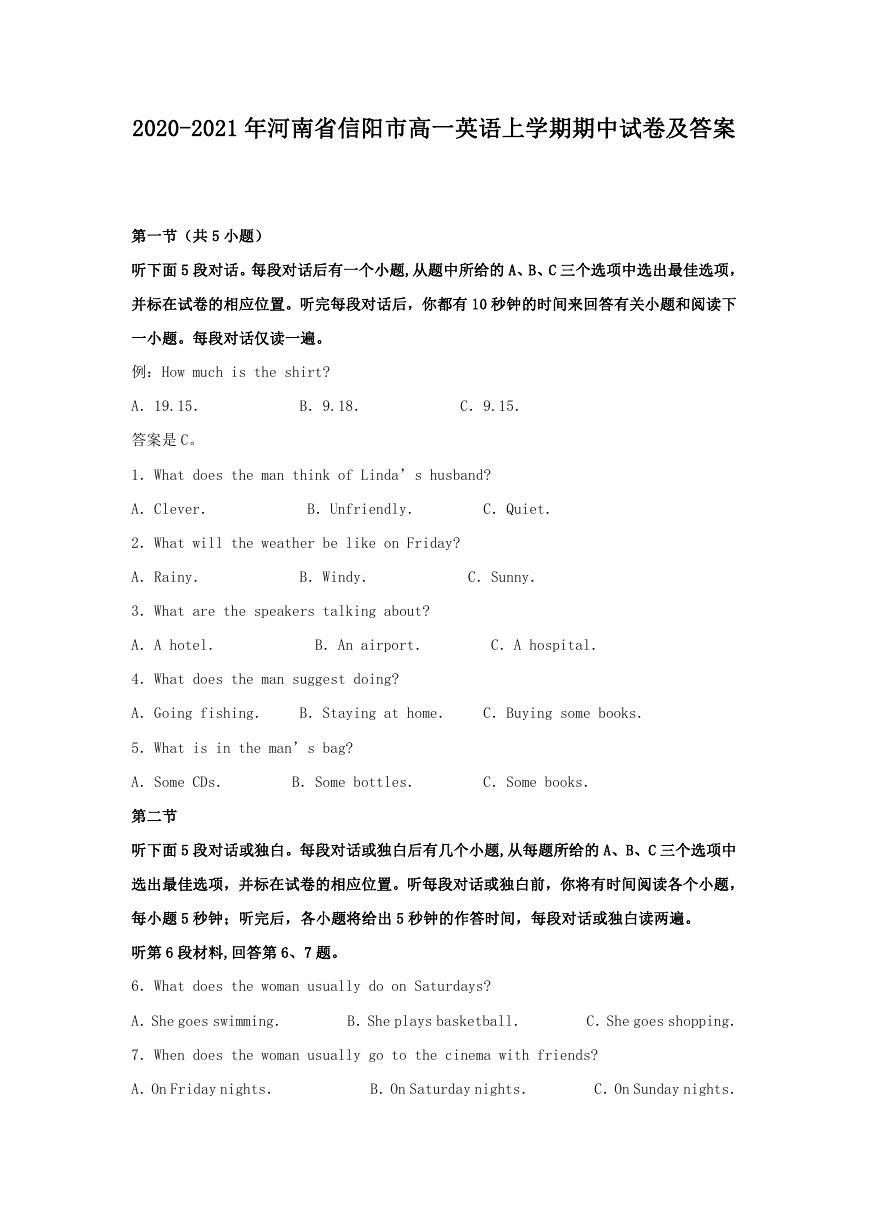
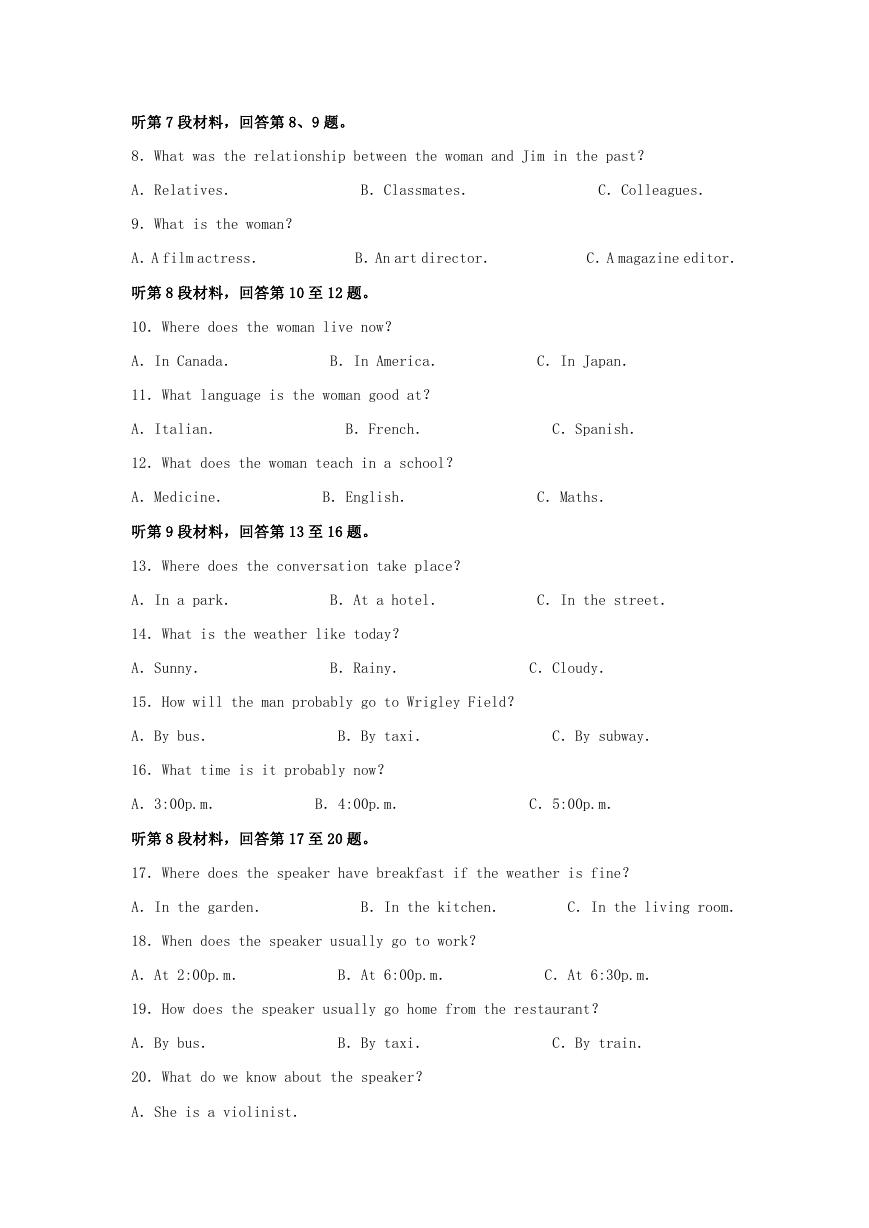
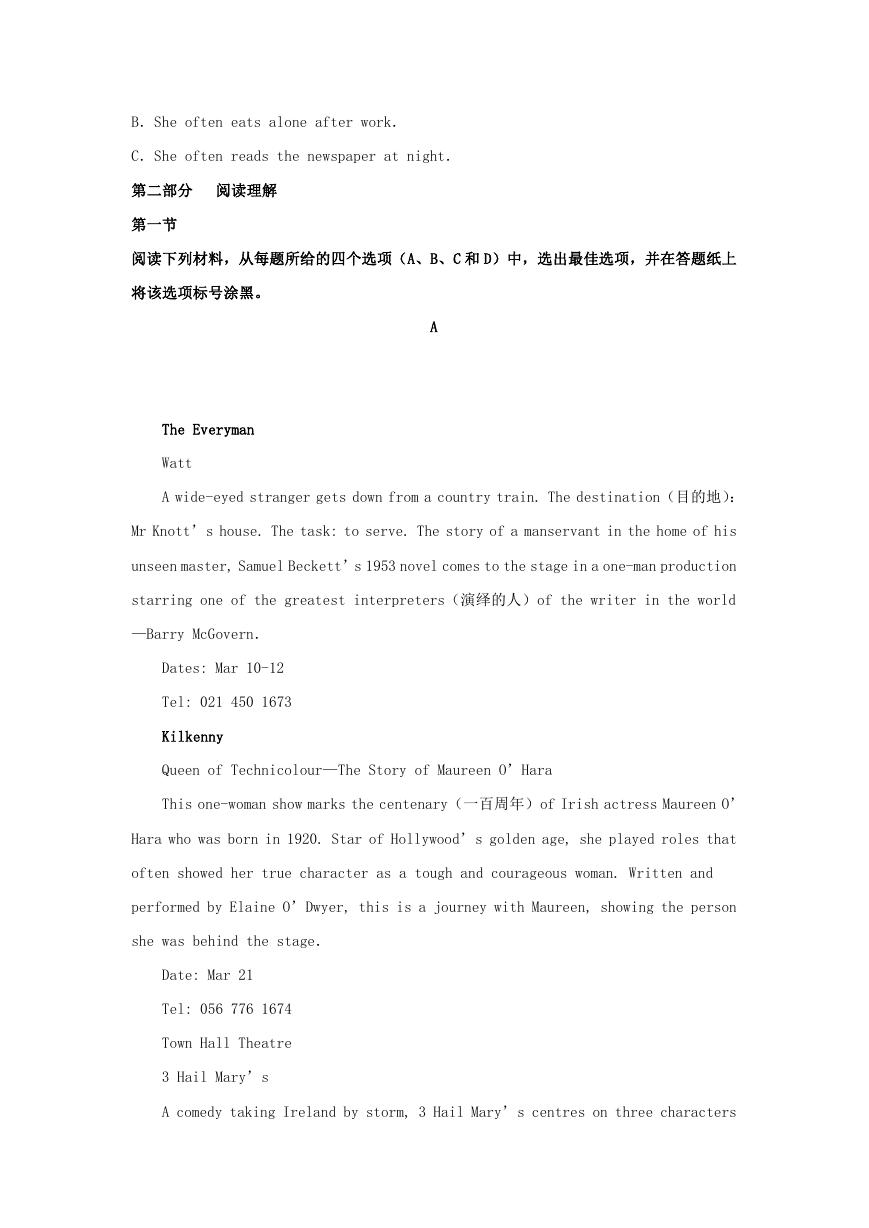
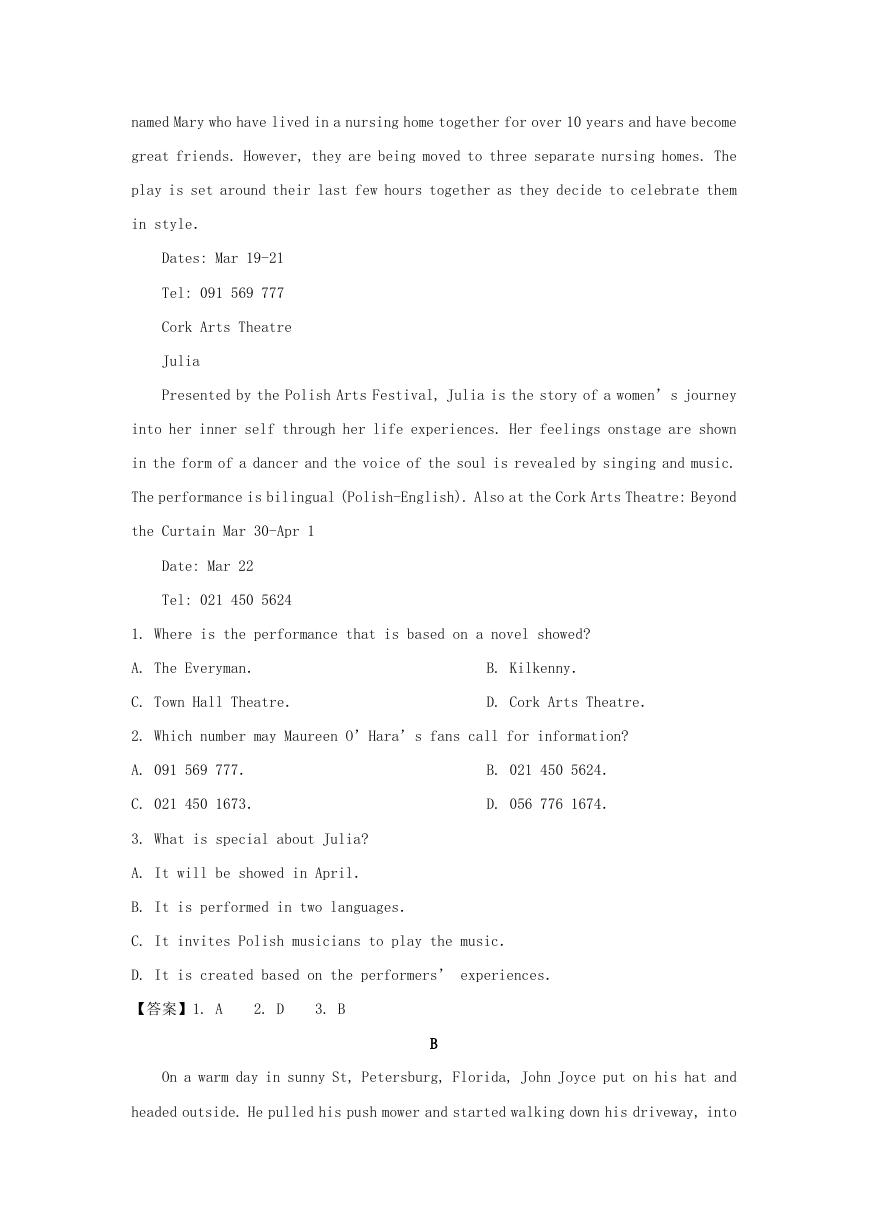
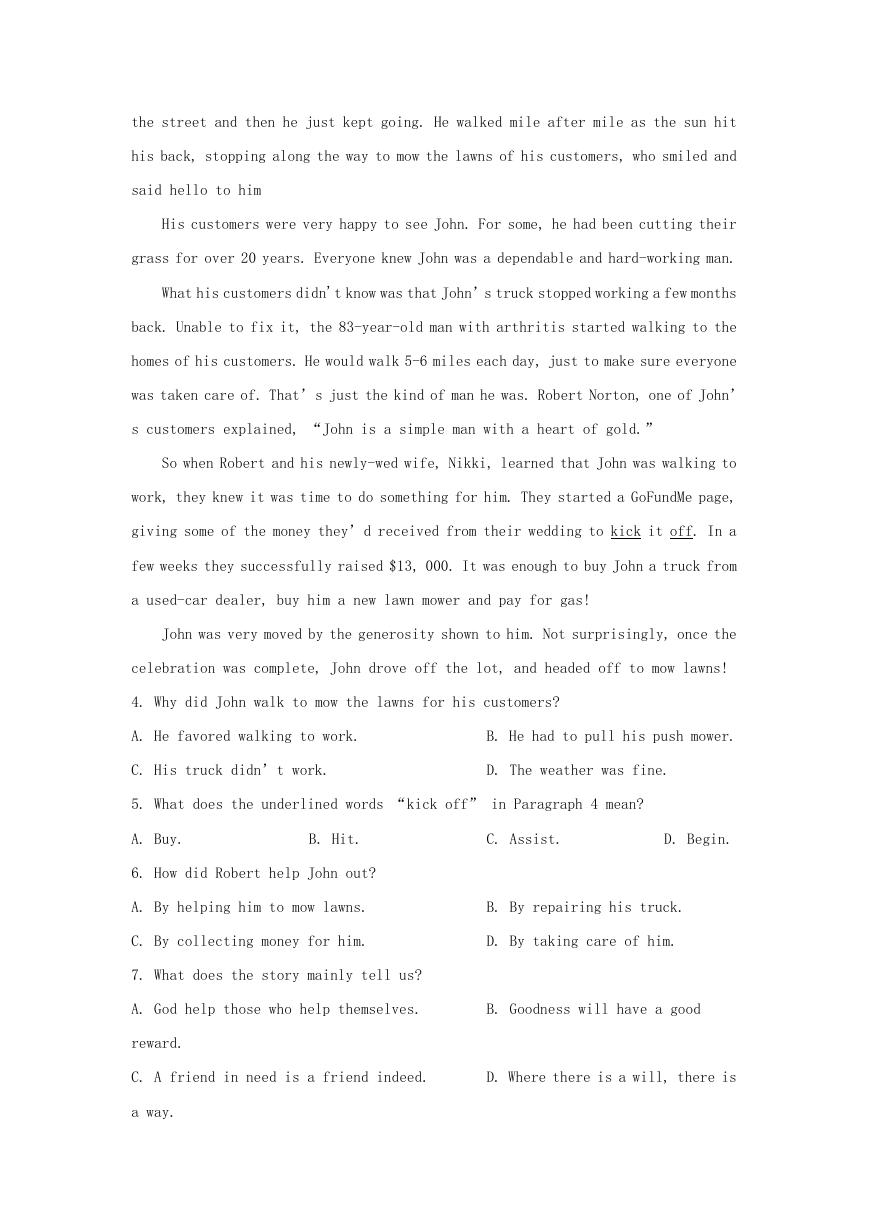
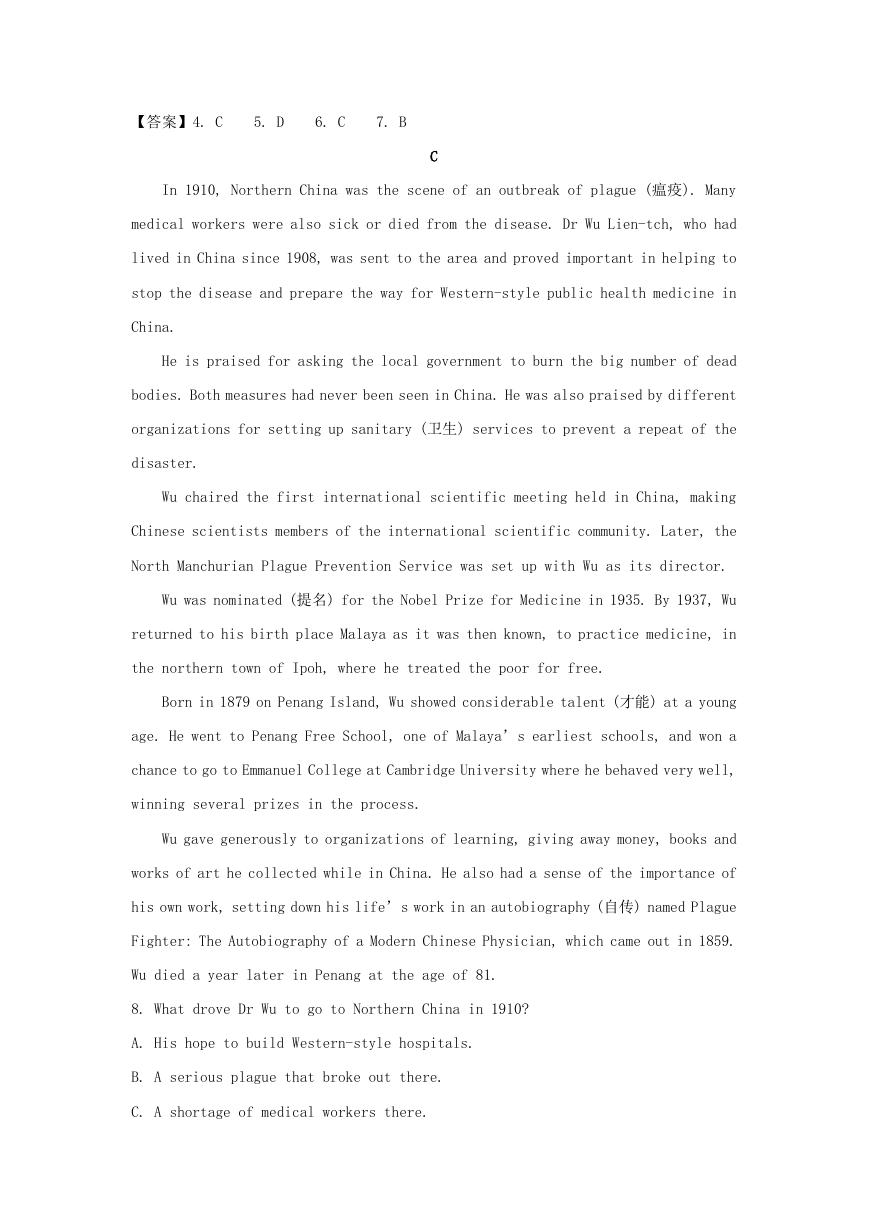
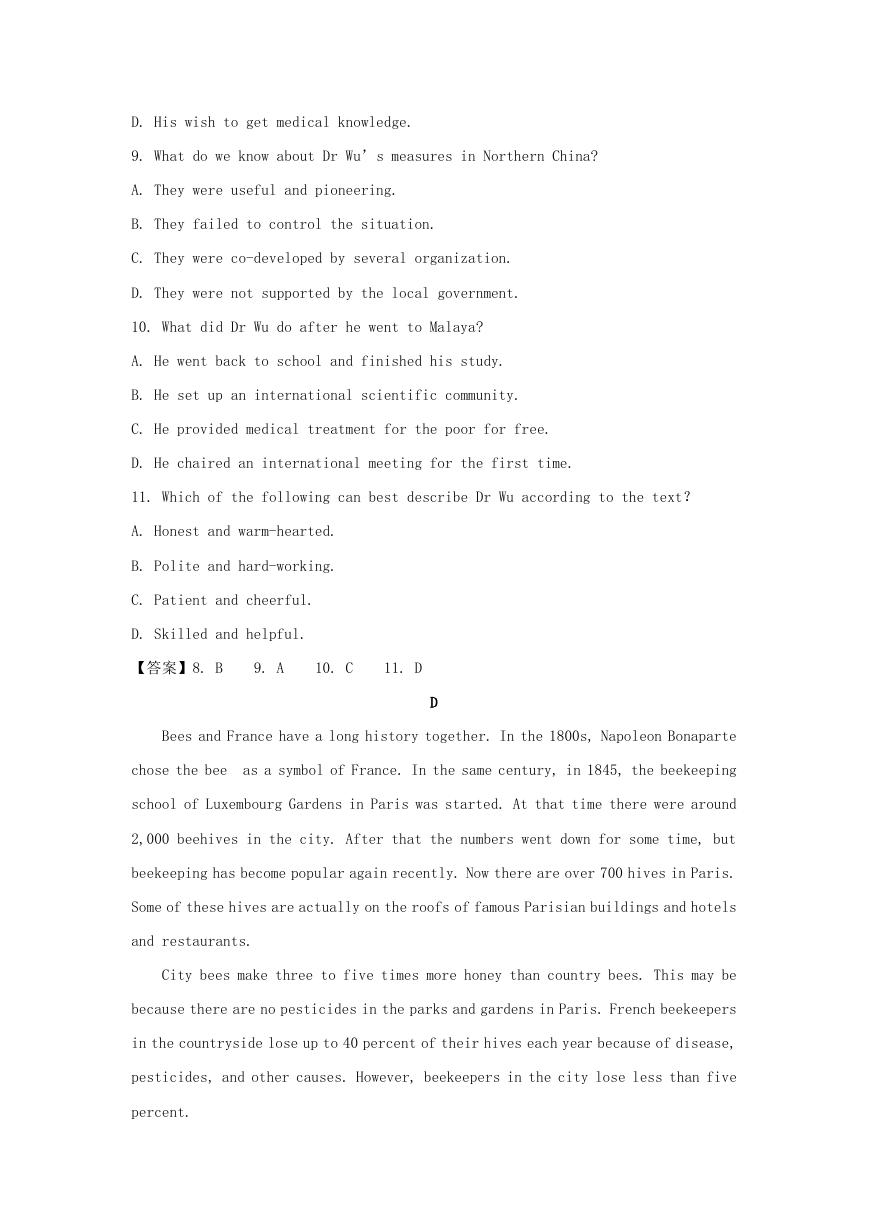
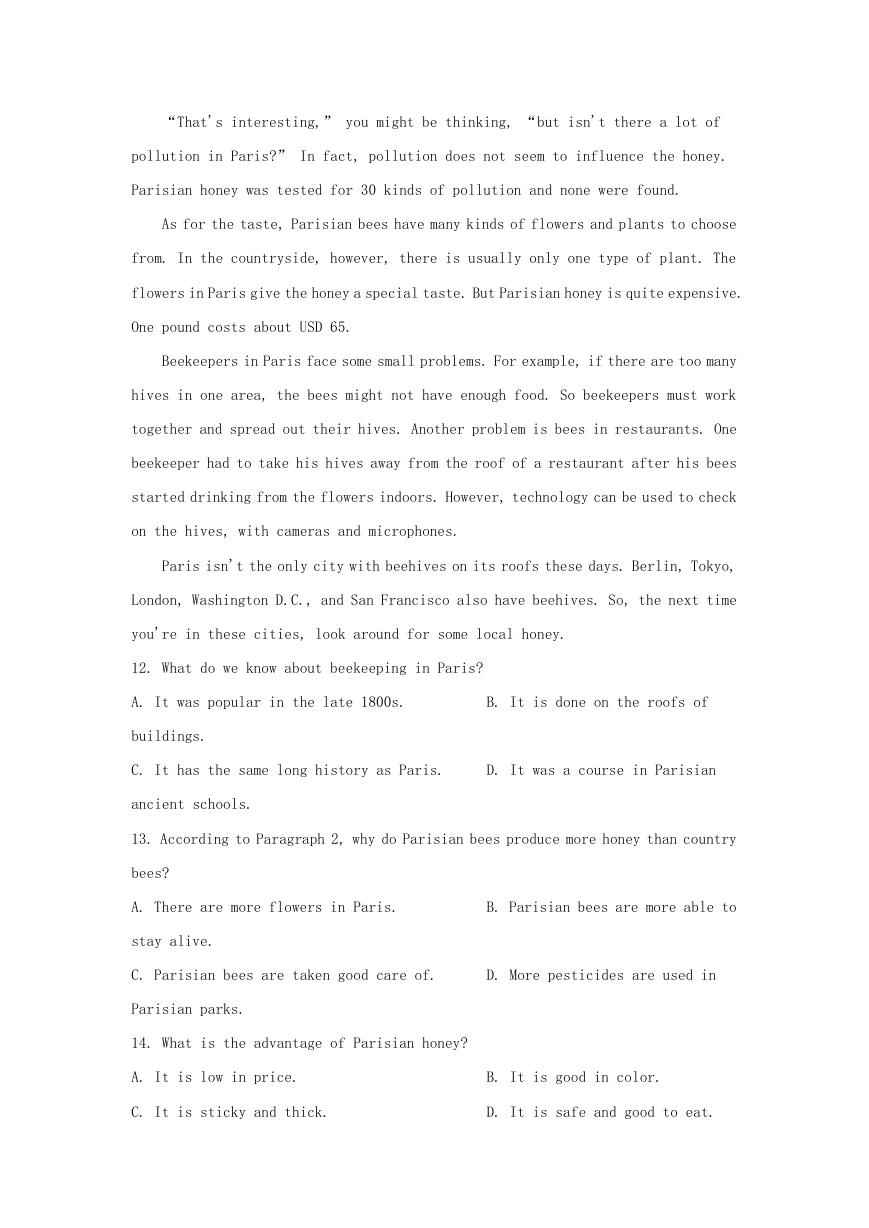








 2023年江西萍乡中考道德与法治真题及答案.doc
2023年江西萍乡中考道德与法治真题及答案.doc 2012年重庆南川中考生物真题及答案.doc
2012年重庆南川中考生物真题及答案.doc 2013年江西师范大学地理学综合及文艺理论基础考研真题.doc
2013年江西师范大学地理学综合及文艺理论基础考研真题.doc 2020年四川甘孜小升初语文真题及答案I卷.doc
2020年四川甘孜小升初语文真题及答案I卷.doc 2020年注册岩土工程师专业基础考试真题及答案.doc
2020年注册岩土工程师专业基础考试真题及答案.doc 2023-2024学年福建省厦门市九年级上学期数学月考试题及答案.doc
2023-2024学年福建省厦门市九年级上学期数学月考试题及答案.doc 2021-2022学年辽宁省沈阳市大东区九年级上学期语文期末试题及答案.doc
2021-2022学年辽宁省沈阳市大东区九年级上学期语文期末试题及答案.doc 2022-2023学年北京东城区初三第一学期物理期末试卷及答案.doc
2022-2023学年北京东城区初三第一学期物理期末试卷及答案.doc 2018上半年江西教师资格初中地理学科知识与教学能力真题及答案.doc
2018上半年江西教师资格初中地理学科知识与教学能力真题及答案.doc 2012年河北国家公务员申论考试真题及答案-省级.doc
2012年河北国家公务员申论考试真题及答案-省级.doc 2020-2021学年江苏省扬州市江都区邵樊片九年级上学期数学第一次质量检测试题及答案.doc
2020-2021学年江苏省扬州市江都区邵樊片九年级上学期数学第一次质量检测试题及答案.doc 2022下半年黑龙江教师资格证中学综合素质真题及答案.doc
2022下半年黑龙江教师资格证中学综合素质真题及答案.doc